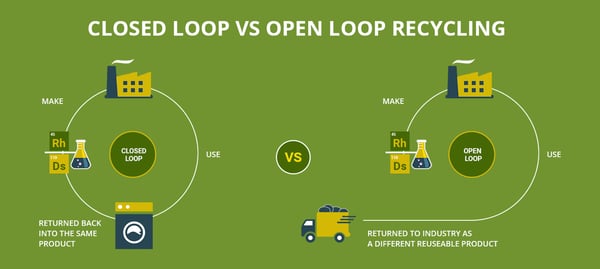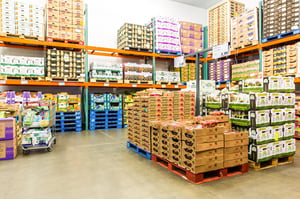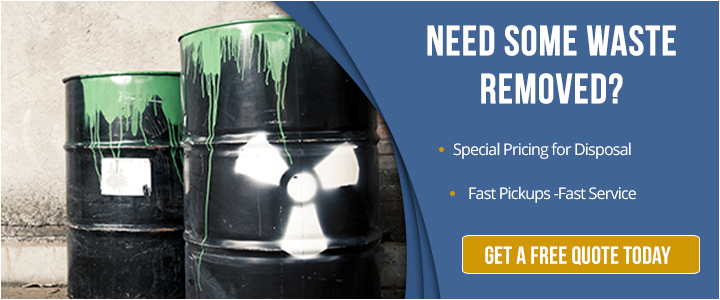As companies look for ways to increase their sustainability, they naturally turn to recycling as a way to keep their waste out of landfills.
However, not all recycling is created equal. While open loop recycling (recycling a product into a different product) still holds value, closed loop recycling is a more sustainable solution.
What is closed loop recycling? Closed loop recycling is a process where waste is collected and recycled. However, rather than use that waste to make a new product, the waste used again to make the same product. This recycling process is regenerative by design and works to keep materials at their highest utility and value. It also helps to conserve natural resources while reducing the need for new raw materials.

Closed loop recycling is highly sustainable, allowing companies to enter the zero waste market since the recycling of a material can be done indefinitely without any of the properties degrading.
If your company is exploring ways to achieve the highest level of sustainability, here are four examples of closed loop recycling that can provide you with inspiration to get started.
1. Unwanted Garments
Women’s fashion label Eileen Fisher is designing a future without waste. Since 2009, the clothing manufacturer has taken back over 1 million pieces of clothing consumers no longer want or need.
The company then gives those textiles a second life by either reselling them through its Renew program or taking damaged clothing and transforming them into other textiles.
Although it’s considered a “take back program,” the initiative is part of an overall goal of the company to commit to circular design.
The textile industry offers a unique opportunity to reinvent fashion and contribute to a circular economy. Considering that every second, the equivalent of a garbage truck load of clothes is burnt or buried in a landfill, according to the Ellen MacArthur Foundation, this contribution to establishing a circular economy is needed now more than ever to protect the environment.
2. Magnet Recycling
Urban Mining recycles neodymium-iron-boron magnets, also known as NdFeB magnets, from goods that have reached the end of their lifespans. These magnets are commonly found in consumer electronics and automobiles.
Urban Mining takes scrap magnets, reprocesses them and turns them into custom-made magnets.
Not only does this example of closed loop recycling promote sustainability and keep waste out of landfills, but it also offers a source for manufacturers domestically while reducing the need for heavy rare earth elements that are needed to achieve high magnetic performance.
3. Food Industry Boxes
Plastpac creates Polycrate boxes that growers and shippers use to pack their produce and prepare items for shipment. To increase the company’s sustainability, it has developed a closed loop recycling program that enables its Polycrate boxes to be picked up from a depot, bailed in full loads.
shippers use to pack their produce and prepare items for shipment. To increase the company’s sustainability, it has developed a closed loop recycling program that enables its Polycrate boxes to be picked up from a depot, bailed in full loads.
When a recycling company picks up the bales from a retailer, that retailer receives a rebate, incentivizing businesses to participate in this process.
After the recycler picks up the bales, it converts them into resin pellets. Plastpac then buys back the resin pellets from the recycler and manufactures new boxes. These boxes are 100% free of contamination and are ready for re-use in the supply chain.
4. Solvent Distillation
More manufacturing companies are discovering the benefits of recycling waste, especially if they produce industrial solvents.
Solvents are molecules that can dissolve other molecules, known as solutes. A solvent can be solid, liquid or gas. Many of these solvents can be recycled, reprocessed and reused. They include halogenated hydrocarbons, alcohols, aromatics, ketones and esters.
Solvent distillation is a process that separates a liquid or vapor mixture of two or more substances into its component fractions of desired purity. After the vapor cools and condenses, the liquid condensate is ready to be sold back into industry.
If there are any portions of the original mixture that do not vaporize, these are not discarded. Instead, these remains are recovered and used as an alternative fuel soure for other industries. In other words, ZERO WASTE is left during the solvent distillation process.
Because industrial solvents are considered hazardous, companies that generate them during a manufacturing process are subject to tight regulations involving their transportation and disposal. That’s why manufacturing facilities turn to hazardous waste disposal companies to transport that solvent waste to solvent distillation or other recycling facilities.
Generators are also subject to cradle to grave requirements, meaning they are responsible for the waste that they generate from the moment it is created to its final disposal. That’s why it’s important to work with a waste transporter that you trust.
Our article, How Industrial Waste Disposal Is Managed, dives into why virtually all waste generators use a reputable disposal company and how you can ensure you partner with a certified waste disposal service to help you with all of your waste management needs.


Comment